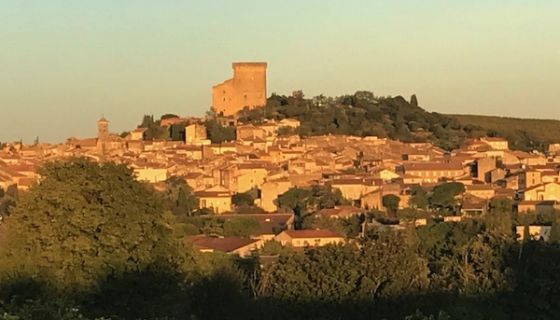8 June 2017 We are republishing this nine-year-old article from our members' section Purple Pages in our Throwback Thursday series in preparation for tomorrow's wine of the week.
15 January 2008 See my tasting notes on about 165 red 2006 Châteauneufs and 65 white 2006 Châteauneufs.
I wrote recently in praise of the new, improved white Châteauneuf, but red Châteauneuf has been delightfully easy to like for years and years – not least this century, which has seen only one less-than-delicious vintage in 2002. This is also a perfect time of year for those of us in the northern hemisphere to enjoy the rich, comforting character of a good red Châteauneuf. All that alcohol can seem a bit much in the middle of summer but in cold weather the wines can seem like the vinous equivalent of the most ambrosial daube. It’s also important to drink these wines in the right circumstances, with substantial food and with a careful eye on serving temperatures. Young wines can taste pretty tough if served too cool, especially the many made in dry years that have quite tough tannins – and reds tend to go through the same surly middle age as I described for the whites. Fully mature Châteauneuf on the other hand can taste so sweet that it’s important to keep it refreshing by serving it slightly cooler than you would a young vintage.
Although prices of Châteauneuf have gone up, and not just because of the strength of the euro, this pretty little appellation still offers an enormous amount of pleasure and notable complexity per penny when compared with good-quality burgundy and, especially, bordeaux. Although the top names Ch de Beaucastel, Clos des Papes and, under new management, Ch Rayas are still basking in glory, there are now dozens and dozens more worthwhile producers than there were even 10 years ago when the great majority of growers sold their fruit to the local co-ops rather than being winemakers themselves. I asked those working at the Fédération, the largest of Châteauneuf’s several generic bodies, for some measure of the increase in number of producers. 'Oh, there’s a new name every month', I was told. And winemaking quality is in general hearteningly high.
Mainly under the auspices of these generic bodies, I tasted all the wines below blind and in random order (apart from Ch de Beaucastel and Clos des Papes, whose wines I tasted only at those properties). It was all the more impressive then that I gave uniformly high scores to virtually the entire range of all the producers listed below, by no means all of which are well-known names.
In fact the only small fly in the ointment is the increasing prevalence of cuvées spéciales, special bottlings of fruit considered superior or different in some way, whose prices tend too easily to the stratospheric and whose existence surely in some cases impoverishes the regular blend. It’s heartening to see that the garlanded Clos des Papes, for example, produces one and only one cuvée, albeit from many different soils, expositions and grape varieties (a factor that gives so much interest to so many Châteauneufs). Clos des Papes, for example, as recently as 2005 added a small plot of extremely ancient Grenache vines to its holdings (see below). Please note that in my blind tastings the special cuvées were served in a different group from the regular, 'Tradition’ bottlings – although I didn’t always find them superior.
Paul-Vincent Avril described vintage 2006 as hot and dry, resulting in low yields, but well-kept vines didn’t seem to suffer (they just seem to be getting used to desert conditions down here!) and the musts had very good (low) pHs so that acidification was not generally necessary at Clos des Papes. He doesn’t think there is much difference at all in quality (as opposed to character) between 2005 and 2006, although he noted that those who picked too early will have made wines with very dry tannins. “We don’t make wines at 15% for fun – just so we can have properly ripe tannins.”
For Alain Dugas of Ch de la Nerthe, on the other hand, 2006 is distinctly superior to 2005. He argues it is of a similar standard to 1998 and 2001. 'It has everything going for it: elegance, tannin structure, purity of fruit and complexity'. His argument is that the rain arrived at the perfect point in 2006 – 20 mm at the end of August – stimulating the ripening process. At Vieux Télégraphe the Bruniers consider 2006 fresher but simpler than 2005 – 'less deep, a bit like 2004' whereas in 2005 some vines shut down. François Perrin of Ch de Beaucastel pointed out that the difference between the two years was that both enjoyed very hot, fine days but in 2006 the nights were much cooler than in 2005, which has resulted in the 2006s’ very attractive (to me) freshness of fruit and slightly lower alcohol levels on average.
I must say I was terribly impressed by the character and purity of the 2006s in general. This is not shorthand for saying they under-delivered. These are wonderfully ripe wines that in general carry their weight particularly well.
Many individual wines were very good indeed but the following producers were especially good performers over a range of wines tasted blind:
Dom de la Barroche (all but the regular bottling)
La Bastide St-Dominique
Dom des Chanssaud
Clos du Caillou
Clos St-Jean
Cuvée du Vatican
Ch Fortia (top cuvées)
Galet des Papes
Ch Gigognan
Giraud
Dom de la Janasse
Dom de Marcoux
Roger Perrin
Dom St-Paul
Dom de la Solitude
Raymond Usseglio
Ch de Vaudieu
For the detail of this enthusiasm, see my tasting notes on about 165 red Châteauneufs and about 60 white Châteauneufs.













